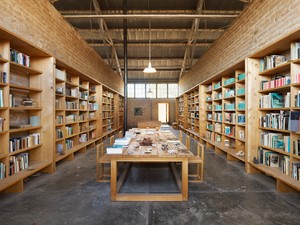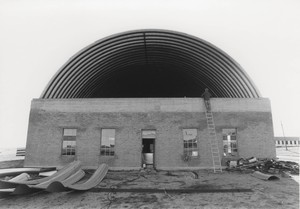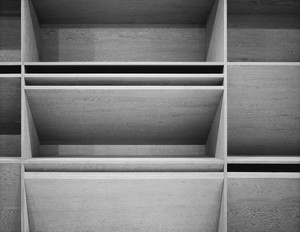Donald Judd: Untitled: 1970
In this video, Flavin Judd, the artist’s son and artistic director of Judd Foundation, discusses a historic large-scale work by his father from 1970, ahead of its presentation at Art Basel Unlimited 2024.
Everything sculpture has, my work doesn’t.
—Donald Judd
Donald Judd’s radical work and thinking helped shape the look of the late twentieth century and continues to influence artists, architects, and designers worldwide. He has exercised a transformative influence over the ways in which both art objects and practical designs are produced, exhibited, encountered, and used.
Judd was born in 1928 in Excelsior Springs, Missouri. After serving in the United States Army in Korea from June 1946 until November 1947, he returned to the US and attended the College of William and Mary in Williamsburg, Virginia; the Art Students League of New York; and Columbia University in New York, where he completed a BS in philosophy in 1953. He went on to work toward a master’s degree in art history at Columbia. From 1959 to 1965, Judd was a prolific critic for magazines including Arts, Art International, and Art News; he continued to write throughout his career, addressing the relationship of art practice to architecture, design, political action, and lived experience in letters and published essays. As an artist, he started out as a painter before turning to three-dimensional work.
In the early 1960s Judd wrote a number of essays calling for the rejection of illusionism in favor of an art of tangible substance. In doing so, he aligned himself with other artists, including John Chamberlain and Dan Flavin, whose work also incorporated commonplace and industrial materials. He began to employ fabricators to produce his work, expanding the studio process in a way that also influenced the emergent Conceptual art movement. Recognizing the physical environment as intrinsic to his work, Judd came to address spatial concerns through three-dimensional form, and the mid-to-late 1960s saw him produce many iconic works including the “stacks”—which are hung at regular intervals in a vertical configuration—and “progressions”—the measurements of which are determined by numerical sequences.
In 1963, Green Gallery in New York held Judd’s first solo exhibition of mature work, and in 1966, Leo Castelli organized what would be the first in an extended series of solo exhibitions for the artist. In 1966, he participated in Primary Structures, a pivotal exhibition at the Jewish Museum, New York, curated by Kynaston McShine. Critically acclaimed for its innovative contextualization of geometric and reductive aesthetics, McShine’s exhibition also resonated with Judd’s artistic approach in its specific organization of objects in relation to the space of the gallery.
In the mid-1960s, Judd began making hollow metal boxes, many with colored interiors, which he placed directly onto the floor, breaking with the use of pedestals traditional to sculpture. In attempting to erase the physical and psychological distance between object and observer, Judd aimed to make his works part of their environment, and of the viewer’s world. This intention resonated with his ideas about the permanent installation of artworks, which he developed further with his 1968 purchase of 101 Spring Street, a five-story building in SoHo, New York, that served as a residence and studio for the next twenty-five years. In 1973, he began acquiring properties in Marfa, Texas, installing his own and other artists’ work there until his death in 1994.
Judd aimed to preserve his art, spaces, libraries, and archives as a lasting resource, and to this end defined the principles of Judd Foundation in 1977. He also founded the Chinati Foundation/La Fundación Chinati in 1986 for the permanent installation of large-scale works by himself and his contemporaries. Major exhibitions include the Whitney Museum of American Art, New York (1968 and 1988); Stedelijk Van Abbemuseum, Eindhoven, Netherlands (1970); National Gallery of Canada, Ottawa (1975); Tate Modern, London (2004); and Museum of Modern Art, New York (2020–21).

In this video, Flavin Judd, the artist’s son and artistic director of Judd Foundation, discusses a historic large-scale work by his father from 1970, ahead of its presentation at Art Basel Unlimited 2024.

The Fall 2022 issue of Gagosian Quarterly is now available, featuring Jordan Wolfson’s House with Face (2017) on its cover.

In this second installment of a two-part essay, Julian Rose continues his exploration of Donald Judd’s engagement with architecture. Here, he examines the artist’s proposals for projects in Bregenz, Austria, and in Basel, arguing that Judd’s approach to shaping space provides a model for contemporary architectural production.

Richard Shiff speaks with Caitlin Murray, director of archives and programs at Judd Foundation, about the archive of Donald Judd, how to approach materials that occupy the gray area between document and art, and some of the considerations unique to stewarding an archive housed within and adjacent to spaces conceived by the artist.

Julian Rose explores the question: what does it mean for an artist to make architecture? Delving into the archives of Donald Judd, he examines three architectural projects by the artist. Here, in the first installment of a two-part essay, he begins with an invitation in Bregenz, Austria, in the early 1990s, before turning to an earlier project, in Marfa, Texas, begun in 1979.
Art historian Eileen Costello and Yale School of Art professor Marta Kuzma discuss Donald Judd’s two-dimensional work and how the lessons he learned from the innovations of Abstract Expressionist and Color Field paintings permeate his entire body of work. Their conversation is moderated by Caitlin Murray, director of archives and programs at Judd Foundation.
Peter Ballantine, Donald Judd’s longtime fabricator of plywood works, and Martha Buskirk, professor of art history and criticism at Montserrat College of Art in Beverly, Massachusetts, discuss the development, production, and history of the largest plywood construction Judd ever made, an untitled work from 1980.
In this video, Flavin Judd, the artist’s son and artistic director of Judd Foundation, leads a walkthrough of the exhibition Donald Judd: Artwork: 1980 at Gagosian, West 21st Street, New York. Flavin connects the work to the concurrent retrospective at the Museum of Modern Art, New York, and the permanent installations in Marfa, Texas, highlighting how it fits within Judd’s oeuvre.

Flavin Judd, the artist’s son and artistic director of Judd Foundation, speaks with Kara Vander Weg about the recent installation of the sculptor’s eighty-foot-long plywood work from 1980 at Gagosian, New York.
Request more information about
Donald Judd